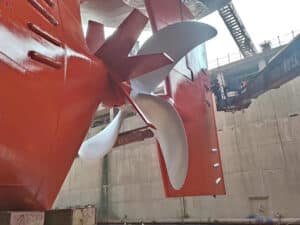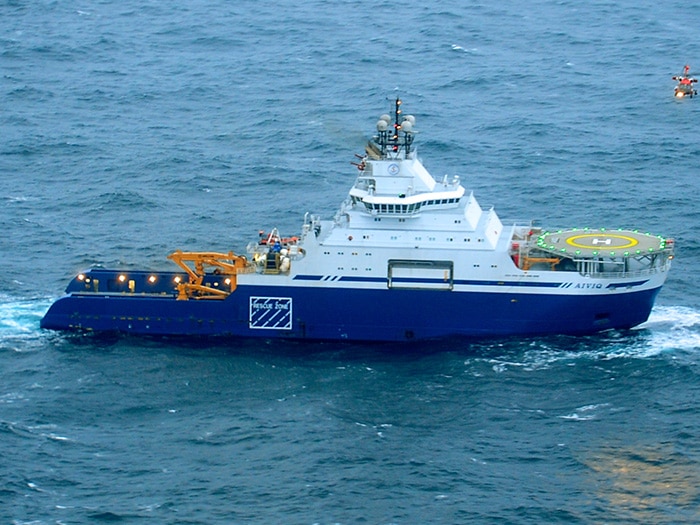
Funding for Chouest icebreaker Aiviq included in FY2024 Homeland Security Appropriations Act
Written by Nick Blenkey
M/V Aiviq off Alaska in 2012. [USCG photograph]
Alaska U.S. Senators Dan Sullivan and Lisa Murkowski (both R.-Alaska) and Representative Mary Peltola (D.-Alaska) today announced that they have successfully secured federal funding for the purchase of a commercially available Icebreaker by the U.S. Coast Guard. Though the legislators did not state the name of the icebreaker, the most frequently mentioned candidate vessel has been Edison Chouest Offshore’s M/V Aiviq. Back in May 2022, the Coast Guard issued an RFI seeking to identify commercial vessels available for purchase that were constructed at a U.S. shipyard and are capable of operating in or around the Arctic. The USCG said in the RFI that was looking to identify commercial vessels available for purchase in 2023 or 2024 and meeting requirements that, essentially, made the Aiviq appear to be the only possible choice.
Back in 2017, Aiviq was one of several candidate vessels suggested for conversion to Canadian Coast Guard icebreakers by Davie Shipyard under its Project Resolute proposal.
According to the legislators, the FY2024 Homeland Security Appropriations Act includes $125 million to purchase the icebreaker. The delegation has also secured commitments from the Coast Guard that the icebreaker will be homeported in Juneau, Alaska to afford the vessel greater access and reach into the Arctic.
The FY 2024 Homeland Security Appropriations Act is part of the just-released Further Consolidated Appropriations Act of 2024, which the House and Senate will consider in the next few days.
“The inclusion of funding for the first icebreaker in a generation is significant progress for our state and our country’s national security,” said Senator Sullivan. “I recently got the Commandant of the Coast Guard to recommit to me that this icebreaker will be homeported in Alaska. Our national security interests in the Arctic have never been more critical. Since coming to the Senate, I’ve been working relentlessly to wake up our federal government to the strategic importance of this region. The sea change we’ve achieved since 2015 is unprecedented: Serious Arctic security strategies from the Department of Defense (DOD) and each of the military services, a new DOD Arctic Security Studies Center at JBER, a new Department of Homeland Security Arctic Domain Awareness Center at UAA, America’s first deep-water Arctic port in Nome, a massive increase in Coast Guard vessels and infrastructure throughout Alaska that I secured working with the previous commandant, and now, we’ve secured funding for the first additional American icebreaker in a generation. We have a lot more work to do, but this is an important milestone and I know that the entire community of Juneau is working hard to prepare for it.”
“I have been fighting for most of my career in the Senate to bolster America’s icebreaker fleet – and today is a critical milestone in that mission,” said Senator Murkowski. “Over the last eight years, I have overseen over a billion and half dollars towards the Polar Security Cutter Program (PSC) so that we can strategically compete in the Arctic. Through the purchase of this commercially available icebreaker, and by protecting against further cuts to the PSC Program, our icebreaker fleet is back on the right track. I have elevated this to the highest priority within the White House and Congress – and I won’t rest until our icebreaker fleet is the envy of the Arctic.”
“Adding icebreaker to the Coast Guard’s fleet will allow the United States to conduct important missions, project American presence, and take a leadership position in the Arctic as it opens up,” said Representative Peltola. “Every Alaskan knows that our state makes the United States an Arctic nation, and that Arctic issues are Alaskan issues. It’s never been more essential for the United States to be a leader in the Arctic, and this is a major step in that direction.”
A backgrounder from the legislators notes that the United States currently has only one operational heavy icebreaker, the Polar Star, and one medium icebreaker, the Healy, while Russia has 55 icebreakers and they are building more. By 2025, China, which has no sovereignty over any Arctic waters, is set to surpass the United States’ icebreaker fleet.
The delegation has long since recognized this as a competitive disadvantage in the Arctic and advocated for additional resources to bolster the USCG icebreaker fleet. The Coast Guard section of the FY 2024 Homeland Security Appropriations Act allocates $125 million to purchase the icebreaker, so that the medium icebreaker would be available for use by the USCG.
This funding is a result of over four years of advocacy by Senator Sullivan and his colleagues in the House of Representatives and Senate and engagement over the span of two Administrations with senior leaders in the USCG, Department of Homeland Security, National Security Council, Office of Management & Budget. Senator Sullivan provided specific authorization for the acquisition of the vessel and provided expedited procurement authority for the vessel as part of the Don Young Coast Guard Authorization Act of 2022. That bill also authorized the conveyance of 2.4 acres of waterfront property from NOAA to the Coast Guard to facilitate the icebreaker homeporting in Juneau. That transfer was completed on February 7, 2024.
Senator Sullivan also put a hold on certain USCG promotions until the Coast Guard produced a long promised study on the homeporting of an icebreaker in Alaska—which ultimately recommended Juneau as the preferred homeporting location.
In the House, Representative Peltola worked with colleagues on both sides of the aisle to ensure Lower 48 members would support the acquisition of a new icebreaker, putting pressure on Democratic leadership to secure this key priority for Alaska.
The delegation makes no mention of what the cost of conversion of the Aiviq would be or how long it would take. A just updated Congressional Research Service Report notes that the Aiviq was built by Edison Chouest in 2012 for $200 million was intended for Shell’s oil exploration in the Beaufort and Chukchi seas. Its ice classification would accommodate work in the Arctic for six months of the year and in Antarctica for four months of the year, but it would require significant modifications to adapt it to the
Coast Guard’s specifications.




